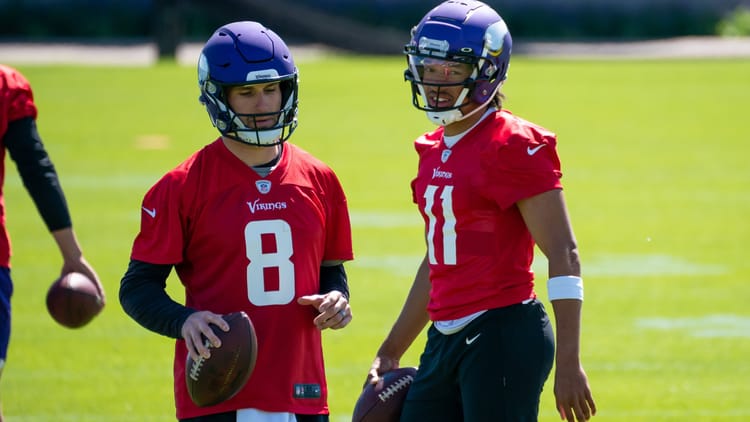Where Can the Minnesota Vikings Improve In the Passing Game?

The main focus all offseason for the Minnesota Vikings was improving their defense. In 2020, the unit underwent turnover while suffering injuries to veterans all across the board. The expectation on offense, meanwhile, has been to keep the status quo. The team had the fourth-ranked offense in the NFL last year. Improve the defense and all should be peachy in the world, right?
Unfortunately, although the Vikings touted the fourth-most yards in the NFL last season, they only scored the 11th-most points. The passing attack, led by the polarizing Kirk Cousins, only ranked 14th in yards. Even for a team that wants to rely on its running game, they can only go as far as Cousins takes them (on Saturday, we saw what can happen if he isn’t in the lineup). So I decided to dig deeper into their aerial attack and decipher what went right, what went wrong, and what needs to change heading into the 2021 season for the Vikings passing game to improve by looking through Pro Football Focus’ premium stats. Qualifiers for each area came down to the top 20 passers in terms of yardage gained.
Passes Behind the Line of Scrimmage
First, we’ll look at passes thrown behind the line of scrimmage. Among all passers in 2020, Kirk ranked 13th overall with 400 passing yards when the ball was thrown in the backfield. However, he was one of the more efficient quarterbacks in the league with these passes. While his 83.1 completion percentage on these throws ranked third-worst for passers with 300 or more yards from this distance, his 6.2 yards-per-attempt was sixth-highest among the qualifying group. His three touchdown passes were tied for fourth in the league. He also held the second-highest passer rating (107.7, behind only Patrick Mahomes) among the demographic.
It shouldn’t be surprising as these passes are deemed the safest passes a quarterback can throw, but this was the one depth of target that Kirk threw zero interceptions. Having said that, there is room for these numbers to improve in 2021; out of the 20 quarterbacks to eclipse the 300-yard mark, only Baker Mayfield and Deshaun Watson had a lower percentage of their dropbacks resulting in passes behind the LOS. But with Mayfield running the show for old Vikings OC Kevin Stefanski, maybe it has more to do with the scheme than anything, and we can expect a lower quantity of these passes, albeit for bigger chunks, again in 2021.
Short Passes (0-9 Yards)
Next, we’ll take a look at the short passing game that begins at the LOS. Kirk once again performed well in this area. This is a good thing, as he and every other qualifying QB finds most of their production in this area. 46.1 percent of Kirk’s dropbacks came during the short game for example. His 1,817 yards in the area ranked sixth in the league.
Again, Kirk was efficient here. His 7.6 yards-per-attempt was second among all qualifying quarterbacks behind only Teddy Bridgewater. When Kirk was throwing outside of the numbers, he was near-perfect. On passes outside of the numbers to the left, he was 49-of-53 for 398 yards, two touchdowns, and zero interceptions. When he threw outside of the numbers to the right side, he was 44-of-56 for 416 yards, five touchdowns, and one interception.
Unfortunately, inside the numbers is where we first see things get a little shaky for our beloved QB. Although he was 104-of-129 here for seven touchdowns, Kirk also threw three picks. His four total interceptions in the short area were tied for fourth-most in the league with seven other quarterbacks. He still held the third-highest passer rating among qualifying quarterbacks, though, so it was still a pretty positive showing.
Intermediate Passes (10-19 Yards)
Perhaps nowhere did Kirk perform better on the field than his work attacking the intermediate area. Kirk’s 1,207 yards in the area ranked eighth in the league. From there, though, his numbers jump out. He tied with Derek Carr for the highest depth-of-target among the 20 passers at 14.4 yards. But Kirk was much more efficient as his yards-per-attempt was 12.2, more than anyone else in the top 20 (Carr, meanwhile, only had 10 yards-per-attempt). And Kirk’s 70.7 completion percentage was way ahead of his contemporaries. For example, second among all qualifiers was Drew Brees. He completed 66.3 percent of his passes.
Once again, we find mostly positive results when looking at Kirk’s pass distribution in the intermediate area. He was once again unstoppable on passes to the left side, completing 19-of-27 passes for 333 yards, four touchdowns, and no picks. In the middle of the field, he was 31-of-42 passing for 539 yards, five scores, and two interceptions. This is a congested part of the field, so the two picks aren’t very alarming in this area. Even Tom Brady threw for three scores to go with four interceptions in this area.
Where things maybe didn’t go as well was in the intermediate area to the right side. Kirk completed 20-of-30 passes, but only threw one touchdown against two interceptions. He still threw for 335 yards, though, so it wasn’t as if this was a stifling area to throw into. But moving forward, turnovers to the outside are dangerous as they have a higher chance of becoming pick-sixes.
Deep Pass (20-plus Yards)
This is where things get muddy. Kirk’s 841 passing yards on deep passes only ranked 13th in the league. His eight touchdown passes ranked 11th, but his five interceptions were tied for second-highest among all quarterbacks. His yards-per-attempt was 12.9, only 15th among qualifiers (in a very surprising stat, this was actually more than Mahomes by a full yard). And finally, his average depth of target was 27.3 yards, the second-lowest of all top-20 yardage leaders.
When throwing to the deep left, Cousins was deadly once again, completing 12-of-24 passes for 374 yards, four touchdowns, and one pick. Passing to the deep right was a little bit more of an adventure as he still completed 13-of-29 passes for four touchdowns along with three interceptions. But it was the deep center of the field that spelled doom for Kirk and the Vikings. He was a paltry 3-of-12 for only 77 yards, zero touchdowns, and one pick. For comparison’s sake, even 43-year-old Tom Brady found success in the deep middle. Although he threw two interceptions, he was still 10-of-27 for 369 yards and two touchdowns. This was Brady’s worst area as well, but teams still had to respect that there was a threat here.
Justin Jefferson scored Pro Football Focus grades of 89 or higher at every zone beyond the LOS except for the deep middle. In fact, he was only targeted twice there all year, catching one pass for 22 yards. Adam Thielen was a deep threat once again, just not in the middle of the field. Three passes were thrown his way in the deep middle. He caught one of them for 30 yards.
What This Means For 2021
The 2020 season didn’t begin as a banner year for Kirk Cousins, but he still had a good season overall. Fans can expect something in the neighborhood once again of 4,000 yards passing, 30 touchdowns, and around ten interceptions. Which side of that number Kirk ends with will tell a lot about the season as his numbers are consistently in this range.
Where these yards, touchdowns, and interceptions come will either spell disaster or success for the Vikings. Throwing the ball well in 13 of 14 areas of the field is great until you realize that the deep middle can extend from 20 yards all the way to the endzone. That’s a lot of wasted real estate inside a $1 billion stadium.
This doesn’t mean that Kirk and the Vikings aren’t capable of these plays, though. In 2019, Kirk was 9-of-17 passing over the deep middle for 327 yards, six touchdowns, and only one interception. This was spearheaded by Stefon Diggs who caught 6-of-10 passes his way for 246 yards and four touchdowns. Thielen caught both passes thrown in his direction in the deep middle for 60 yards and two touchdowns. Irv Smith, Jr., just like in 2020, caught the one other pass in the deep middle for 21 yards.
What this says is that as good of a season as Justin Jefferson had in 2020, he still has room to improve. If he can exploit the deep middle of defenses, then that should open things for Thielen to do his own damage. The team also needs another receiver to step up, whether that’s Smith, who is faster than former Viking Kyle Rudolph, or one of the young receivers vying for the WR3 spot.
The Vikings have a good offense and a myriad of weapons. If they can build on what they did in 2020 and attack even more of the field, the 2021 unit can once again be productive, and hopefully even more efficient.
